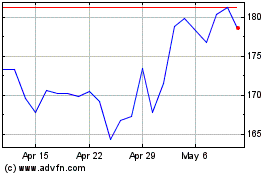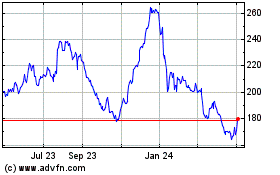By Andy Pasztor
Boeing Co. is grappling with still another software problem that
has cropped up in its effort to fix its 737 MAX aircraft, adding to
technical issues that have complicated and delayed the grounded
fleet's return to service over many months.
The latest glitch, which Boeing said Friday it was working to
correct, prevents the jet's flight-control computers from powering
up and verifying they are ready for flight, according to industry
and government officials.
"We are making necessary updates and working with the FAA on
submission of this change, and keeping our customers and suppliers
informed," a Boeing spokesman said.
Before the problem was discovered last week, according to people
briefed on the details, the company and the Federal Aviation
Administration were slated to conduct a key certification flight by
the end of this month. But at this point, these people said, that
date increasingly looks like it will slip into at least
February.
The length of the delay will largely depend on how long it takes
Boeing engineers to address the problem and verify its elimination,
though coordination with international regulators and other factors
could complicate the process.
It also isn't clear how much of a delay the problematic software
could create in the end since various other regulatory steps
affecting the MAX's return, including finalizing pilot-training
requirements, are running late and remain in limbo.
U.S. carriers already have pulled MAX jets from their schedules
through early June, though industry and government officials
project that the planes could start making demonstration flights
with airline executives on board weeks before that.
The MAX fleet was grounded in March, not long after the second
of two crashes that killed a total of 346 people.
The software problem occurred as engineers were loading updated
software -- including an array of changes painstakingly developed
over roughly a year -- into the flight-control computers of a test
aircraft, according to one person briefed on the details.
A software function intended to monitor the power-up process
didn't operate correctly, according to this person, resulting in
the entire computer system crashing. Previously, proposed software
fixes had been tested primarily in ground-based simulators, where
no power-up problems arose, this person said.
The revised software is intended to fix an automated
flight-control system called MCAS that led to the two fatal
crashes, in 2018 and 2019. The system, new on the MAX, misfired in
a way that repeatedly and forcefully pushed the planes' noses down,
overpowering pilot commands and ending in fatal dives. The company
has been developing revised software intended to make the system
less prone to such misfires and easier for pilots to
counteract.
Boeing also has increased redundancy by having the plane's dual
flight-control computers operate throughout each flight, a change
that industry and government officials said has entailed more
software changes than Boeing initially anticipated.
FAA and Boeing officials were in the midst of analyzing
prospects for the latest software revisions when Steve Dickson, the
agency's administrator, met with newly installed Boeing chief Dave
Calhoun early this week. Neither government nor Boeing officials
have commented on that session.
In addition to completion of the software fixes, the MAX's
return to service is subject to test flights by a representative
group of international airline pilots, along with public comments
on the details of extra training for cockpit crews.
The FAA also has to approve changes to operating and training
manuals, endorse revised emergency procedures and sign off on
maintenance and inspections of planes that have been in storage,
some for many months.
Numerous foreign regulators have signaled they won't approve
resumption of passenger flights until their own engineering and
pilot-training reviews are finished.
Nevertheless, the coming certification flight is widely
considered the next major step to ease the MAX crisis, which has
cost Boeing and the global airline industry billions of dollars and
disrupted flight schedules around the world.
If resolving the most recent software errors takes longer than a
few weeks, the MAX's overall return to service timeline could take
another significant hit.
Initially, Boeing and many of its airline customers expected
that a software fix dealing solely with the shortcomings of MCAS
could be rolled out fairly quickly.
After a Lion Air jet went down in Indonesia in October 2018, the
plane maker and FAA experts projected the necessary changes could
be made, tested, approved and implemented world-wide in seven
months. But as U.S. and international regulators delved into other
aspects of the flight-control computers, new safety concerns arose
that prompted months of further analysis and testing.
During the summer, changes to emergency procedures and issues
regarding reliability of computer hardware prompted more studies
and software tweaks. Months later, regulators balked at what they
considered Boeing's failure to promptly provide data backing up
software changes, prompting another slowdown in the process.
The MAX's return also faces significant challenges when it comes
to changes in software used in flight-simulators to train
pilots.
Such devices are in short supply world-wide, and some of those
that are available have somewhat different software configurations
depending on when they were updated and certified by regulators. As
a result, some airlines are concerned that pilots trained on early
versions may have to be recalled and run through follow-up
simulator sessions to comply with eventual safety mandates.
Write to Andy Pasztor at andy.pasztor@wsj.com
(END) Dow Jones Newswires
January 17, 2020 18:56 ET (23:56 GMT)
Copyright (c) 2020 Dow Jones & Company, Inc.
Boeing (NYSE:BA)
Historical Stock Chart
From Mar 2024 to Apr 2024

Boeing (NYSE:BA)
Historical Stock Chart
From Apr 2023 to Apr 2024
